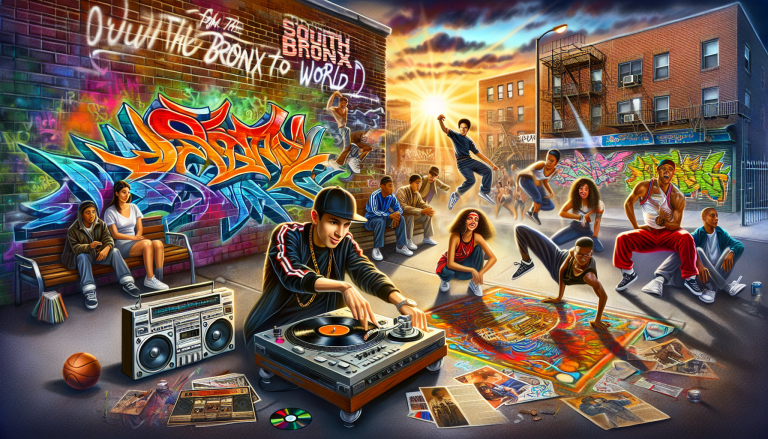The Birth of a Cultural Revolution: Hip-Hop’s Genesis
Let’s spin the record back to the South Bronx, early 1970s—a bubbling cauldron of creativity simmering amid urban struggles and relentless spirit. Hip-hop wasn’t just music; it was a cultural explosion that emerged from the streets, born from block parties thrown by visionaries like DJ Kool Herc. This genre exploded from a need to express, to tell stories raw and real, stitched with the pulse of rhythm and poetry. Hip-hop’s foundation is a vibrant tapestry of DJing, MCing (rapping), breakdancing, and graffiti art—a quartet of elements all intertwined in a symphony of urban expression.
American music underwent a seismic shift when hip-hop dropped its beat, disrupting traditional soundscapes with syncopated percussion and powerful, lyrical narratives. It was rebellion, storytelling, and celebration rolled into one—a soundtrack for the unheard voices. The Bronx, a peppered stew of cultural diversity and hardship, proved the perfect incubator for hip-hop’s birth, turning adversity into infectious beats and lyrical prowess.
A Sonic and Cultural Phenomenon: What Defines Hip-Hop?
Hip-hop’s essence lies in its rhythm-driven backbone: the beat, often crafted with turntables and drum machines, crafted into hypnotic loops known as “breaks.” Atop this percussive playground, MCs unleash lyrical fire, crafting rhymes that range from social commentary to braggadocio, wit to emotional depth. The genre’s multiverse is vast—encompassing everything from gangster rap’s raw street narratives to conscious hip-hop’s socially aware messages.
Instrumentation is a mosaic of samples—snippets grabbed from funk, soul, jazz, and even little-known records, woven into new compositions. This sampling culture is a testament to hip-hop’s reverence for its musical ancestors while pushing the sonic envelope into uncharted terrain. Dance music and EDM may share a penchant for rhythm and groove, but hip-hop’s heartbeat pulses with storytelling and verbal dexterity, anchored in community and identity.
Architects of the Movement: The Titans of Hip-Hop

Any deep dive into hip-hop must salute pioneers who shaped its trajectory. DJ Kool Herc, often dubbed the “Father of Hip-Hop,” ignited it all with his innovative use of breakbeats in hosting block parties. From there, Grandmaster Flash elevated DJ techniques with cutting, scratching, and mixing, forever changing how beats were constructed and experienced.
Enter the lyrical legends: Run-D.M.C. took hip-hop to a mainstream stage in the ‘80s, blending rock elements to craft anthems like “It’s Tricky” that still electrify dance music enthusiasts today. Public Enemy’s Chuck D wielded hip-hop as a weapon of socio-political critique, transforming rap into a platform for activism. The Notorious B.I.G. and Tupac Shakur carved new emotional dimensions into the genre, narrating life’s dualities with raw honesty that transcended generations.
Modern torchbearers like Kendrick Lamar, J. Cole, and Missy Elliott continue to evolve hip-hop, blending experimental soundscapes with razor-sharp lyricism, proving the genre’s potency and adaptability have aging-proofed it in a rapidly shifting musical landscape.
Anthems and Albums that Shook the World
Few genres boast albums that become cultural milestones; hip-hop proudly wears that crown. Run-D.M.C.’s “Raising Hell” (1986) smashed barriers, bringing rap into colossal arenas with its hard-hitting beats and street-smart hooks. Public Enemy’s “It Takes a Nation of Millions to Hold Us Back” (1988) didn’t just entertain—it challenged, provoked, and educated, embedding hip-hop firmly in the realm of serious art.
The 1990s unleashed a golden era: Nas’s “Illmatic” (1994) is a lyrical masterpiece, a poetic chronicle of urban life that still resonates decades later. “The Chronic” by Dr. Dre (1992) introduced G-Funk, a laid-back yet funky style that became synonymous with West Coast hip-hop and influenced both dance music producers and hip-hop artists.
Tracks like “Juicy” by Notorious B.I.G., “Dear Mama” by Tupac, and “Lose Yourself” by Eminem (from the 2002 “8 Mile” soundtrack) embody hip-hop’s emotional and cultural spectrum. These songs blend rhythm and storytelling to create anthems for generations, inviting listeners to both nod their heads and think deeply.
The Undeniable Legacy: Hip-Hop’s Lasting Effects
Hip-hop’s influence stretches far beyond the turntables and microphones; it reshaped culture globally. It injects authenticity and attitude into American music, influencing pop, rock, and yes, even EDM and dance music. The genre’s rhythmic complexities and sampling mindset inspired EDM artists to incorporate hip-hop’s groove-driven sensibilities into their synth-heavy tracks, creating electrifying fusions that move club crowds around the world.
Hip-hop also catalyzed fashion, language, and attitude, becoming a blueprint for modern youth identity and cultural dialogue. Its commercial success spawned an entire entertainment ecosystem—films, fashion brands, and multimedia ventures—that continue amplifying its global pulse.
More than sounds or beats, hip-hop carries an enduring message of creativity born from adversity, a communal voice and cultural mirror reflecting society’s highs, lows, and infinite shades in between. It’s a cyclic dance of innovation, raising the bar for artistry in any genre it touches, from gritty rap battles to euphoric EDM drop moments.
To experience hip-hop is to witness a raw, unfiltered chronicle of life’s rhythm—rough edges, poetic depth, and beats that refuse to quit. It’s the sonic heartbeat of a movement, a genre that forever urged us to “break” the mold and dance to our own stories. Whether you’re spinning tracks as a DJ or vibing at the club, hip-hop’s legacy resounds: relentless, unstoppable, and irresistibly alive.